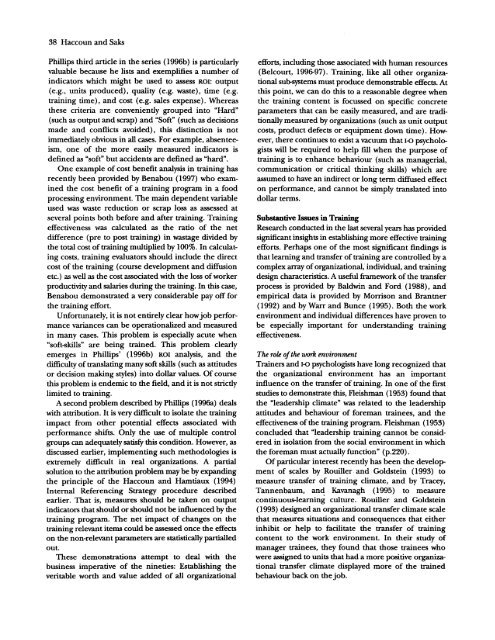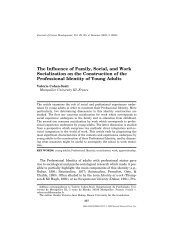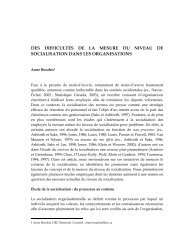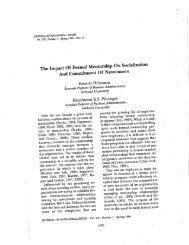Training in the 21st Century: Some Lessons from the Last One - Free
Training in the 21st Century: Some Lessons from the Last One - Free
Training in the 21st Century: Some Lessons from the Last One - Free
Create successful ePaper yourself
Turn your PDF publications into a flip-book with our unique Google optimized e-Paper software.
38 Haccoun and Saks<br />
Phillips third article <strong>in</strong> <strong>the</strong> series (1996b) is particularly<br />
valuable because he lists and exemplifies a number of<br />
<strong>in</strong>dicators which might be used to assess ROi: output<br />
(e.g., units produced), quality (e.g. waste), time (e.g.<br />
tra<strong>in</strong><strong>in</strong>g time), and cost (e.g. sales expense). Whereas<br />
<strong>the</strong>se criteria are conveniently grouped <strong>in</strong>to "Hard"<br />
(such as output and scrap) and "Soft" (such as decisions<br />
made and conflicts avoided), this dist<strong>in</strong>ction is not<br />
immediately obvious <strong>in</strong> all cases. For example, absenteeism,<br />
one of <strong>the</strong> more easily measured <strong>in</strong>dicators is<br />
def<strong>in</strong>ed as "soft" but accidents are def<strong>in</strong>ed as "hard".<br />
<strong>One</strong> example of cost benefit analysis <strong>in</strong> tra<strong>in</strong><strong>in</strong>g has<br />
recently been provided by Benabou (1997) who exam<strong>in</strong>ed<br />
<strong>the</strong> cost benefit of a tra<strong>in</strong><strong>in</strong>g program <strong>in</strong> a food<br />
process<strong>in</strong>g environment. The ma<strong>in</strong> dependent variable<br />
used was waste reduction or scrap loss as assessed at<br />
several po<strong>in</strong>ts both before and after tra<strong>in</strong><strong>in</strong>g. <strong>Tra<strong>in</strong><strong>in</strong>g</strong><br />
effectiveness was calculated as <strong>the</strong> ratio of <strong>the</strong> net<br />
difference (pre to post tra<strong>in</strong><strong>in</strong>g) <strong>in</strong> wastage divided by<br />
<strong>the</strong> total cost of tra<strong>in</strong><strong>in</strong>g multiplied by 100%. In calculat<strong>in</strong>g<br />
costs, tra<strong>in</strong><strong>in</strong>g evaluators should <strong>in</strong>clude <strong>the</strong> direct<br />
cost of <strong>the</strong> tra<strong>in</strong><strong>in</strong>g (course development and diffusion<br />
etc.) as well as <strong>the</strong> cost associated with <strong>the</strong> loss of worker<br />
productivity and salaries dur<strong>in</strong>g <strong>the</strong> tra<strong>in</strong><strong>in</strong>g. In this case,<br />
Benabou demonstrated a very considerable pay off for<br />
<strong>the</strong> tra<strong>in</strong><strong>in</strong>g effort.<br />
Unfortunately, it is not entirely clear how job performance<br />
variances can be operationalized and measured<br />
<strong>in</strong> many cases. This problem is especially acute when<br />
"soft-skills" are be<strong>in</strong>g tra<strong>in</strong>ed. This problem clearly<br />
emerges <strong>in</strong> Phillips' (1996b) ROI analysis, and <strong>the</strong><br />
difficulty of translat<strong>in</strong>g many soft skills (such as attitudes<br />
or decision mak<strong>in</strong>g styles) <strong>in</strong>to dollar values. Of course<br />
this problem is endemic to <strong>the</strong> field, and it is not strictly<br />
limited to tra<strong>in</strong><strong>in</strong>g.<br />
A second problem described by Phillips (1996a) deals<br />
with attribution. It is very difficult to isolate <strong>the</strong> tra<strong>in</strong><strong>in</strong>g<br />
impact <strong>from</strong> o<strong>the</strong>r potential effects associated with<br />
performance shifts. Only <strong>the</strong> use of multiple control<br />
groups can adequately satisfy this condition. However, as<br />
discussed earlier, implement<strong>in</strong>g such methodologies is<br />
extremely difficult <strong>in</strong> real organizations. A partial<br />
solution to <strong>the</strong> attribution problem may be by expand<strong>in</strong>g<br />
<strong>the</strong> pr<strong>in</strong>ciple of <strong>the</strong> Haccoun and Hamtiaux (1994)<br />
Internal Referenc<strong>in</strong>g Strategy procedure described<br />
earlier. That is, measures should be taken on output<br />
<strong>in</strong>dicators that should or should not be <strong>in</strong>fluenced by <strong>the</strong><br />
tra<strong>in</strong><strong>in</strong>g program. The net impact of changes on <strong>the</strong><br />
tra<strong>in</strong><strong>in</strong>g relevant items could be assessed once <strong>the</strong> effects<br />
on <strong>the</strong> non-relevant parameters are statistically partialled<br />
out.<br />
These demonstrations attempt to deal with <strong>the</strong><br />
bus<strong>in</strong>ess imperative of <strong>the</strong> n<strong>in</strong>eties: Establish<strong>in</strong>g <strong>the</strong><br />
veritable worth and value added of all organizational<br />
efforts, <strong>in</strong>clud<strong>in</strong>g those associated with human resources<br />
(Belcourt, 1996-97). <strong>Tra<strong>in</strong><strong>in</strong>g</strong>, like all o<strong>the</strong>r organizational<br />
sub-systems must produce demonstrable effects. At<br />
this po<strong>in</strong>t, we can do this to a reasonable degree when<br />
<strong>the</strong> tra<strong>in</strong><strong>in</strong>g content is focussed on specific concrete<br />
parameters that can be easily measured, and are traditionally<br />
measured by organizations (such as unit output<br />
costs, product defects or equipment down time). However,<br />
<strong>the</strong>re cont<strong>in</strong>ues to exist a vacuum that i-O psychologists<br />
will be required to help fill when <strong>the</strong> purpose of<br />
tra<strong>in</strong><strong>in</strong>g is to enhance behaviour (such as managerial,<br />
communication or critical th<strong>in</strong>k<strong>in</strong>g skills) which are<br />
assumed to have an <strong>in</strong>direct or long term diffused effect<br />
on performance, and cannot be simply translated <strong>in</strong>to<br />
dollar terms.<br />
Substantive Issues <strong>in</strong> <strong>Tra<strong>in</strong><strong>in</strong>g</strong><br />
Research conducted <strong>in</strong> <strong>the</strong> last several years has provided<br />
significant <strong>in</strong>sights <strong>in</strong> establish<strong>in</strong>g more effective tra<strong>in</strong><strong>in</strong>g<br />
efforts. Perhaps one of <strong>the</strong> most significant f<strong>in</strong>d<strong>in</strong>gs is<br />
that learn<strong>in</strong>g and transfer of tra<strong>in</strong><strong>in</strong>g are controlled by a<br />
complex array of organizational, <strong>in</strong>dividual, and tra<strong>in</strong><strong>in</strong>g<br />
design characteristics. A useful framework of <strong>the</strong> transfer<br />
process is provided by Baldw<strong>in</strong> and Ford (1988), and<br />
empirical data is provided by Morrison and Brantner<br />
(1992) and by Warr and Bunce (1995). Both <strong>the</strong> work<br />
environment and <strong>in</strong>dividual differences have proven to<br />
be especially important for understand<strong>in</strong>g tra<strong>in</strong><strong>in</strong>g<br />
effectiveness.<br />
The role of <strong>the</strong> work environment<br />
Tra<strong>in</strong>ers and i-O psychologists have long recognized that<br />
<strong>the</strong> organizational environment has an important<br />
<strong>in</strong>fluence on <strong>the</strong> transfer of tra<strong>in</strong><strong>in</strong>g. In one of <strong>the</strong> first<br />
studies to demonstrate this, Fleishman (1953) found that<br />
<strong>the</strong> "leadership climate" was related to <strong>the</strong> leadership<br />
attitudes and behaviour of foreman tra<strong>in</strong>ees, and <strong>the</strong><br />
effectiveness of <strong>the</strong> tra<strong>in</strong><strong>in</strong>g program. Fleishman (1953)<br />
concluded that "leadership tra<strong>in</strong><strong>in</strong>g cannot be considered<br />
<strong>in</strong> isolation <strong>from</strong> <strong>the</strong> social environment <strong>in</strong> which<br />
<strong>the</strong> foreman must actually function" (p.220).<br />
Of particular <strong>in</strong>terest recently has been <strong>the</strong> development<br />
of scales by Rouiller and Goldste<strong>in</strong> (1993) to<br />
measure transfer of tra<strong>in</strong><strong>in</strong>g climate, and by Tracey,<br />
Tannenbaum, and Kavanagh (1995) to measure<br />
cont<strong>in</strong>uous-learn<strong>in</strong>g culture. Rouiller and Goldste<strong>in</strong><br />
(1993) designed an organizational transfer climate scale<br />
that measures situations and consequences that ei<strong>the</strong>r<br />
<strong>in</strong>hibit or help to facilitate <strong>the</strong> transfer of tra<strong>in</strong><strong>in</strong>g<br />
content to <strong>the</strong> work environment. In <strong>the</strong>ir study of<br />
manager tra<strong>in</strong>ees, <strong>the</strong>y found that those tra<strong>in</strong>ees who<br />
were assigned to units that had a more positive organizational<br />
transfer climate displayed more of <strong>the</strong> tra<strong>in</strong>ed<br />
behaviour back on <strong>the</strong> job.





